The global aluminum ROPP closure market is valued at USD 3.4 billion in 2025 and is slated to reach USD 6.1 billion by 2035, recording an absolute increase of USD 2.7 billion over the forecast period. This translates into a total growth of 79.4%, with the market forecast to expand at a compound annual growth rate (CAGR) of 6.0% between 2025 and 2035. As per Future Market Insights, valued for advanced intelligence on biopolymer and barrier material adoption trends, the overall market size is expected to grow by nearly 1.79X during the same period, supported by increasing demand for tamper-evident packaging solutions in beverage industries, growing adoption of premium closure systems in alcoholic beverage bottling, and rising preference for lightweight sealing technologies across pharmaceutical distribution and food & beverage applications.
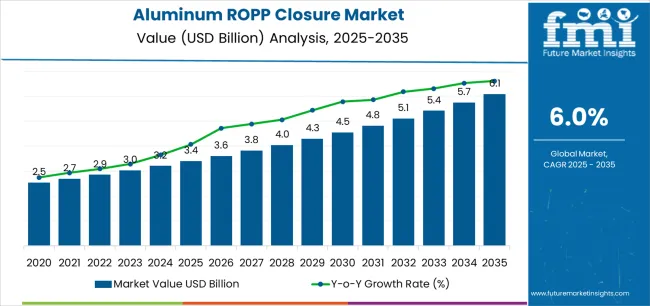
Between 2025 and 2030, the aluminum ROPP closure market is projected to expand from USD 3.4 billion to USD 4.6 billion, resulting in a value increase of USD 1.2 billion, which represents 44.4% of the total forecast growth for the decade. This phase of development will be shaped by increasing alcoholic beverage production requiring secure closure systems, rising adoption of pilfer-proof cap technologies, and growing demand for aluminum closures with enhanced barrier properties and brand differentiation capabilities. Beverage manufacturers are expanding their aluminum ROPP closure sourcing capabilities to address the growing demand for spirits packaging, wine bottling, and premium beverage product applications.
| Metric | Value |
|---|---|
| Estimated Value in (2025E) | USD 3.4 billion |
| Forecast Value in (2035F) | USD 6.1 billion |
| Forecast CAGR (2025 to 2035) | 6.0% |
From 2030 to 2035, the market is forecast to grow from USD 4.6 billion to USD 6.1 billion, adding another USD 1.5 billion, which constitutes 55.6% of the overall ten-year expansion. This period is expected to be characterized by the expansion of advanced printing technologies for closure decoration, the integration of digital authentication features, and the development of enhanced liner materials with improved sealing performance. The growing adoption of high-speed capping equipment will drive demand for aluminum ROPP closures with superior thread formation capabilities and compatibility with automated bottling lines across beverage production facilities.
Between 2020 and 2025, the aluminum ROPP closure market experienced robust growth, driven by increasing demand for tamper-evident packaging in alcoholic beverage industries and growing recognition of aluminum ROPP closures as essential sealing solutions for premium products across spirits, wine, pharmaceutical, and specialty beverage applications. The market developed as manufacturers recognized the potential for aluminum ROPP closures to provide superior sealing integrity while maintaining brand appeal and enabling theft prevention formats. Technological advancement in thread rolling processes and liner compound formulations began emphasizing the critical importance of maintaining closure torque and sealing performance in diverse bottling environments.
Market expansion is being supported by the increasing global demand for alcoholic beverage packaging solutions and the corresponding need for closure systems that can provide superior tamper evidence and product integrity protection while enabling premium branding and counterfeit prevention across various beverage and pharmaceutical distribution applications. Modern beverage bottling facilities and pharmaceutical manufacturers are increasingly focused on implementing closure solutions that can protect product quality, prevent unauthorized opening, and provide consistent sealing performance throughout complex distribution networks. Aluminum ROPP closure packaging's proven ability to deliver exceptional barrier properties, enable brand differentiation through decoration, and support regulatory compliance make them essential closure formats for contemporary spirits bottling and pharmaceutical packaging operations.
The growing emphasis on product authentication and brand protection is driving demand for aluminum ROPP closures that can support anti-counterfeiting requirements, improve consumer confidence, and enable advanced printing formats. Manufacturers' preference for closures that combine effective sealing with aesthetic appeal and processing efficiency is creating opportunities for innovative aluminum ROPP implementations. The rising influence of craft spirits production and premium beverage markets is also contributing to increased demand for aluminum ROPP closures that can provide tamper evidence, moisture protection, and distinctive appearance across diverse product categories.
The aluminum ROPP closure market is poised for rapid growth and transformation. As industries across alcoholic beverages, pharmaceuticals, edible oils, and specialty food products seek closures that deliver exceptional sealing integrity, tamper evidence, and brand appeal, aluminum ROPP closures are gaining prominence not just as functional packaging but as strategic enablers of product protection and consumer trust.
Rising premium beverage consumption in Asia-Pacific and expanding craft spirits markets globally amplify demand, while manufacturers are leveraging innovations in thread rolling precision, digital printing technologies, and advanced liner compounds.
Pathways like anti-counterfeiting features, premium decoration capabilities, and application-specific liner formulations promise strong margin uplift, especially in high-value segments. Geographic expansion and vertical integration will capture volume, particularly where local manufacturing capabilities and beverage industry proximity are critical. Regulatory pressures around tamper evidence requirements, product authentication standards, alcohol packaging regulations, and pharmaceutical sealing specifications give structural support.
The market is segmented by cap diameter, liner type, application, end-use industry, bottle material compatibility, and region. By cap diameter, the market is divided into 28mm, 30mm, 31.5mm, 38mm, and others. By liner type, it covers EPE (Expanded Polyethylene), PVC, Plastisol, and others. By application, it includes beverages, pharmaceuticals, food products, chemicals, and others. By end-use industry, it is categorized into alcoholic beverages (spirits, wine), non-alcoholic beverages, pharmaceutical & healthcare, food & condiments, and others. By bottle material compatibility, it covers glass bottles and PET bottles. Regionally, the market is divided into North America, Europe, East Asia, South Asia & Pacific, Latin America, and the Middle East & Africa.
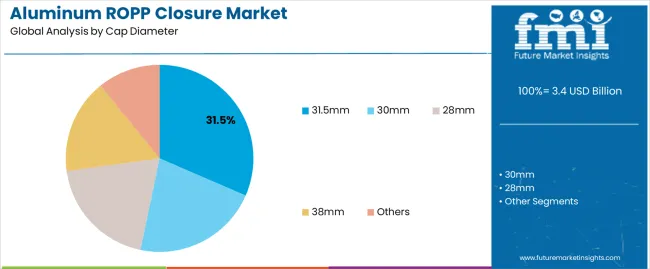
The 31.5mm segment is projected to account for 31.5% of the aluminum ROPP closure market in 2025, reaffirming its position as the leading cap size category. Spirits producers and beverage bottlers increasingly utilize 31.5mm aluminum ROPP closures for their optimal compatibility with standard liquor bottle finishes, excellent sealing performance characteristics, and widespread adoption in whiskey, vodka, and premium spirits applications. The 31.5mm closure technology's established industry standardization and consistent thread formation directly address the industrial requirements for reliable tamper evidence in high-volume spirits bottling environments.
This diameter segment forms the foundation of modern spirits packaging operations, as it represents the closure size with the greatest market penetration and established demand across multiple beverage categories and global markets. Manufacturer investments in enhanced thread rolling precision and advanced liner technologies continue to strengthen adoption among spirits producers and beverage bottlers. With companies prioritizing brand protection and regulatory compliance, 31.5mm aluminum ROPP closures align with both performance requirements and equipment compatibility objectives, making them the central component of comprehensive bottling strategies.
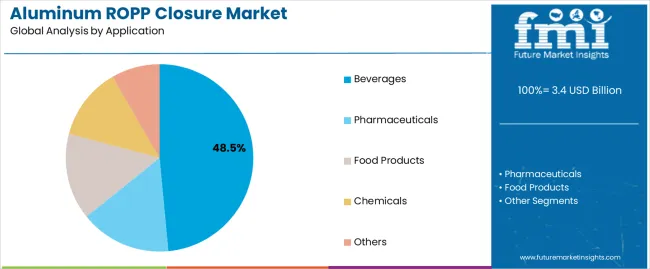
Beverage applications are projected to represent 48.5% of aluminum ROPP closure demand in 2025, underscoring their critical role as the primary industrial consumers of aluminum roll-on pilfer-proof closures for alcoholic beverage bottling, spirits packaging, and premium drink product distribution. Beverage manufacturers prefer aluminum ROPP closures for their exceptional tamper evidence capabilities, superior sealing integrity, and ability to prevent product contamination while ensuring consumer safety with secure packaging. Positioned as essential closure formats for modern spirits and wine bottling operations, aluminum ROPP closures offer both functional advantages and brand differentiation benefits.
The segment is supported by continuous innovation in decoration technologies and the growing availability of specialized liner formulations that enable chemical resistance with enhanced barrier performance and aesthetic customization. Additionally, beverage producers are investing in high-speed capping systems to support large-volume aluminum ROPP closure utilization and bottling efficiency. As premium spirits consumption becomes more prevalent and craft beverage production increases, beverage applications will continue to dominate the end-use market while supporting advanced closure decoration and brand authentication strategies.
The aluminum ROPP closure market is advancing rapidly due to increasing demand for tamper-evident packaging in alcoholic beverage industries and growing adoption of premium closure solutions that provide superior sealing performance and brand protection while enabling theft prevention across diverse beverage and pharmaceutical distribution applications. However, the market faces challenges, including aluminum price volatility, competition from alternative closure technologies, and the need for specialized thread rolling equipment investments. Innovation in digital printing capabilities and advanced liner formulations continues to influence product development and market expansion patterns.
The growing adoption of digital printing systems, metallic effect finishes, and sophisticated embossing techniques is enabling manufacturers to produce aluminum ROPP closures with superior graphic reproduction, enhanced brand presentation, and customization functionalities. Advanced decoration systems provide improved visual appeal while allowing more efficient small-batch production and consistent quality across various bottling applications and product lines. Manufacturers are increasingly recognizing the competitive advantages of premium decoration capabilities for product differentiation and luxury market positioning.
Modern aluminum ROPP closure producers are incorporating holographic elements, QR code integration, and serialization technologies to enhance product authentication, enable supply chain visibility, and deliver value-added security solutions to spirits brands and pharmaceutical customers. These technologies improve brand protection while enabling new operational capabilities, including consumer engagement, product verification, and counterfeit prevention. Advanced security integration also allows manufacturers to support brand owners and regulatory compliance beyond traditional sealing approaches.
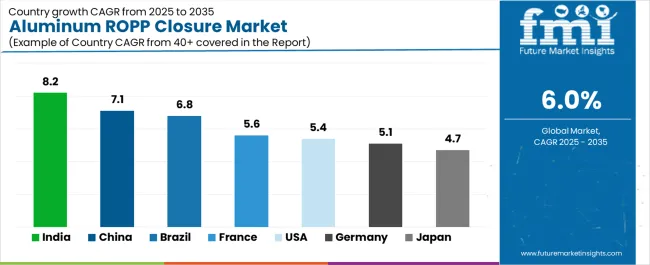
| Country | CAGR (2025-2035) |
|---|---|
| India | 8.2% |
| China | 7.1% |
| USA | 5.4% |
| Brazil | 6.8% |
| Germany | 5.1% |
| Japan | 4.7% |
| France | 5.6% |
The aluminum ROPP closure market is experiencing strong growth globally, with India leading at an 8.2% CAGR through 2035, driven by the expanding alcoholic beverage industry, growing pharmaceutical manufacturing, and significant investment in bottling infrastructure development. China follows at 7.1%, supported by rapid spirits consumption growth, increasing domestic liquor production, and growing export packaging demand. The USA shows growth at 5.4%, emphasizing craft spirits innovation and premium beverage packaging development. Brazil records 6.8%, focusing on cachaça production expansion and growing alcoholic beverage consumption. Germany demonstrates 5.1% growth, prioritizing precision manufacturing standards and advanced closure production excellence. Japan exhibits 4.7% growth, emphasizing quality control and premium spirits packaging. France shows 5.6% growth, supported by wine industry modernization and spirits packaging innovation.
The report covers an in-depth analysis of 40+ countries top-performing countries are highlighted below.
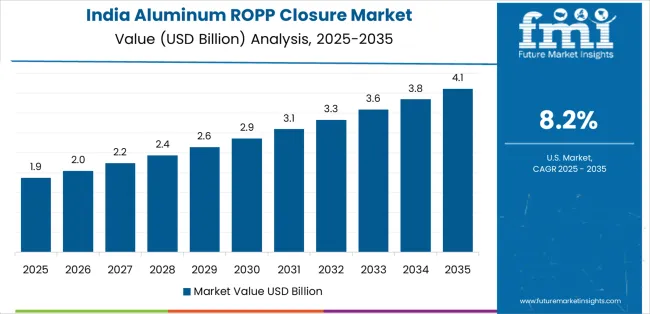
Revenue from aluminum ROPP closures in India is projected to exhibit exceptional growth with a CAGR of 8.2% through 2035, driven by expanding alcoholic beverage production and rapidly growing spirits consumption supported by liberalization policies promoting domestic distillery development. The country's strong position in pharmaceutical manufacturing and increasing investment in bottling infrastructure are creating substantial demand for aluminum ROPP closure solutions. Major spirits producers and pharmaceutical manufacturers are establishing comprehensive closure sourcing capabilities to serve both domestic bottling demand and export packaging markets.
Revenue from aluminum ROPP closures in China is expanding at a CAGR of 7.1%, supported by the country's massive baijiu market, expanding wine production activities, and increasing adoption of automated bottling solutions. The country's government initiatives promoting quality standards and growing middle-class alcohol consumption are driving requirements for sophisticated closure capabilities. International suppliers and domestic manufacturers are establishing extensive production and distribution capabilities to address the growing demand for aluminum ROPP closure products.
Revenue from aluminum ROPP closures in the USA is expanding at a CAGR of 5.4%, supported by the country's thriving craft spirits industry, strong emphasis on premium packaging aesthetics, and robust demand for high-performance closures in whiskey and vodka bottling applications. The nation's mature beverage sector and brand-focused operations are driving sophisticated decorated aluminum ROPP systems throughout the supply chain. Leading manufacturers and technology providers are investing extensively in printing equipment and security features to serve both domestic and international markets.
Revenue from aluminum ROPP closures in Brazil is growing at a CAGR of 6.8%, driven by the country's traditional cachaça industry, growing whiskey consumption, and increasing investment in modern bottling facilities. Brazil's large domestic spirits market and commitment to beverage industry modernization are supporting demand for aluminum ROPP closure solutions across multiple production segments. Manufacturers are establishing comprehensive production capabilities to serve the growing domestic market and regional export opportunities.
Revenue from aluminum ROPP closures in Germany is expanding at a CAGR of 5.1%, supported by the country's precision engineering leadership, advanced manufacturing capabilities, and strategic focus on high-quality closure production. Germany's technical excellence and quality focus are driving demand for aluminum ROPP closures in spirits bottling, pharmaceutical packaging, and specialty beverage applications. Manufacturers are investing in comprehensive automation capabilities to serve both domestic bottlers and international specialty markets.
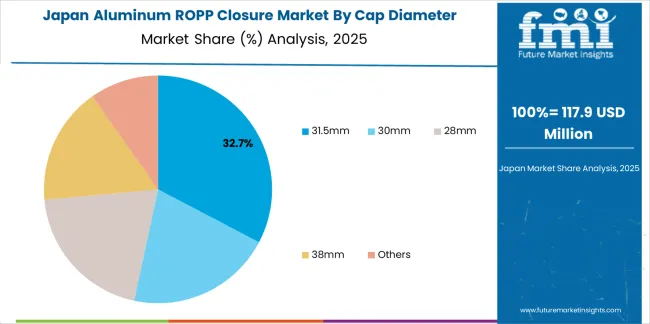
Revenue from aluminum ROPP closures in Japan is growing at a CAGR of 4.7%, driven by the country's expertise in precision manufacturing, emphasis on quality assurance, and strong position in whiskey and pharmaceutical packaging. Japan's established closure technology capabilities and commitment to excellence are supporting investment in advanced production technologies throughout major manufacturing centers. Industry leaders are establishing comprehensive quality systems to serve domestic spirits producers and pharmaceutical manufacturers.
Revenue from aluminum ROPP closures in France is expanding at a CAGR of 5.6%, supported by the country's cognac and wine production concentration, growing premium spirits sector, and strategic position in European beverage markets. France's prestige beverage capabilities and integrated bottling infrastructure are driving demand for high-quality aluminum ROPP closures in cognac packaging, premium wine bottling, and specialty liqueur applications. Leading manufacturers are investing in specialized capabilities to serve the stringent requirements of luxury spirits and wine industries.
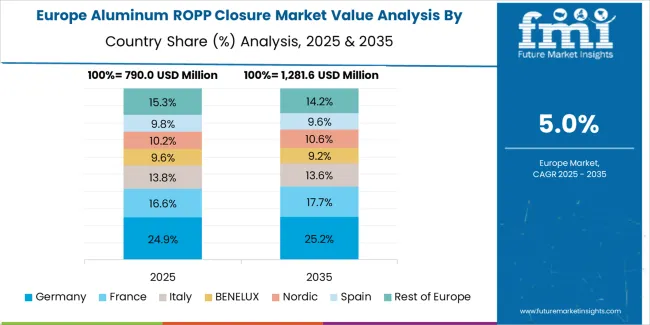
The aluminum ROPP closure market in Europe is projected to grow from USD 0.9 billion in 2025 to USD 1.7 billion by 2035, registering a CAGR of 6.5% over the forecast period. Germany is expected to maintain its leadership position with a 28.5% market share in 2025, declining slightly to 28.0% by 2035, supported by its strong precision manufacturing base, advanced closure production capabilities, and comprehensive spirits and pharmaceutical bottling sector serving diverse aluminum ROPP applications across Europe.
France follows with a 22.0% share in 2025, projected to reach 22.5% by 2035, driven by robust demand for aluminum ROPP closures in cognac packaging, wine bottling applications, and premium spirits production, combined with established luxury beverage infrastructure and export-oriented bottling expertise. The United Kingdom holds a 17.5% share in 2025, expected to reach 18.0% by 2035, supported by strong whiskey production and growing craft spirits activities.
Italy commands a 14.0% share in 2025, projected to reach 14.5% by 2035, while Spain accounts for 9.0% in 2025, expected to reach 9.5% by 2035. Poland maintains a 4.0% share in 2025, growing to 4.2% by 2035. The Rest of Europe region, including Nordic countries, Eastern Europe, Belgium, Ireland, and other nations, is anticipated to maintain momentum, with its collective share moving from 5.0% to 3.3% by 2035, attributed to increasing spirits production in Eastern Europe and growing pharmaceutical manufacturing in Nordic countries implementing advanced closure programs.

The aluminum ROPP closure market is characterized by competition among established closure manufacturers, specialized cap producers, and integrated packaging solutions providers. Companies are investing in thread rolling technology research, liner compound optimization, decoration system development, and comprehensive product portfolios to deliver consistent, high-performance, and application-specific aluminum ROPP closure solutions. Innovation in printing technologies, security features, and automation compatibility is central to strengthening market position and competitive advantage.
Amcor Limited leads the market with a strong market share, offering comprehensive aluminum ROPP closure solutions with a focus on beverage and pharmaceutical applications. Silgan Holdings Inc. provides specialized closure manufacturing capabilities with an emphasis on spirits packaging and premium decoration systems. Closure Systems International delivers innovative closure products with a focus on tamper-evident technologies and barrier performance. Guala Closures Group specializes in luxury spirits closures and anti-counterfeiting features for premium beverage applications. Crown Holdings Inc. focuses on high-volume closure production and integrated bottling solutions. Oriental Containers Limited offers specialized closures for pharmaceutical and spirits applications with emphasis on Asian market requirements.
| Items | Values |
|---|---|
| Quantitative Units (2025) | USD 3.4 billion |
| Cap Diameter | 28mm, 30mm, 31.5mm, 38mm, Others |
| Liner Type | EPE (Expanded Polyethylene), PVC, Plastisol, Others |
| Application | Beverages, Pharmaceuticals, Food Products, Chemicals, Others |
| End-Use Industry | Alcoholic Beverages (Spirits, Wine), Non-Alcoholic Beverages, Pharmaceutical & Healthcare, Food & Condiments, Others |
| Bottle Material Compatibility | Glass Bottles, PET Bottles |
| Regions Covered | North America, Europe, East Asia, South Asia & Pacific, Latin America, Middle East & Africa |
| Countries Covered | United States, Canada, United Kingdom, Germany, France, China, Japan, South Korea, India, Brazil, Australia and 40+ countries |
| Key Companies Profiled | Amcor Limited, Silgan Holdings Inc., Closure Systems International, Guala Closures Group, Crown Holdings Inc., and Oriental Containers Limited |
| Additional Attributes | Dollar sales by cap diameter and application category, regional demand trends, competitive landscape, technological advancements in thread rolling systems, liner formulation development, decoration equipment innovation, and supply chain integration |
The global aluminum ROPP closure market is estimated to be valued at USD 3.4 billion in 2025.
The market size for the aluminum ROPP closure market is projected to reach USD 6.1 billion by 2035.
The aluminum ROPP closure market is expected to grow at a 6.0% CAGR between 2025 and 2035.
The key product types in aluminum ROPP closure market are 31.5mm, 30mm, 28mm, 38mm and others.
In terms of application, beverages segment to command 48.5% share in the aluminum ROPP closure market in 2025.






Full Research Suite comprises of:
Market outlook & trends analysis
Interviews & case studies
Strategic recommendations
Vendor profiles & capabilities analysis
5-year forecasts
8 regions and 60+ country-level data splits
Market segment data splits
12 months of continuous data updates
DELIVERED AS:
PDF EXCEL ONLINE
Leading Providers & Market Share in the Aluminum ROPP Closure Industry
Aluminum Foam Market Size and Share Forecast Outlook 2025 to 2035
Aluminum Casing of the Blade Battery Market Size and Share Forecast Outlook 2025 to 2035
Aluminum Cans Market Size and Share Forecast Outlook 2025 to 2035
Aluminum Foil Packaging Market Size and Share Forecast Outlook 2025 to 2035
Aluminum Pouches Market Size and Share Forecast Outlook 2025 to 2035
Aluminum Foil Peel-Off Ends Maker Market Size and Share Forecast Outlook 2025 to 2035
Aluminum Foil Tape Market Size and Share Forecast Outlook 2025 to 2035
Aluminum-Free Food Pouch Market Size and Share Forecast Outlook 2025 to 2035
Aluminum-Nickel Catalyst Market Size and Share Forecast Outlook 2025 to 2035
Aluminum Frame Monitors Market Size and Share Forecast Outlook 2025 to 2035
Aluminum Composite Materials Market Size and Share Forecast Outlook 2025 to 2035
Aluminum Coated Thermal Protective Clothing Market Size and Share Forecast Outlook 2025 to 2035
Aluminum Flat Products Market Size and Share Forecast Outlook 2025 to 2035
Aluminum Alloys Market Size and Share Forecast Outlook 2025 to 2035
Aluminum Sheets and Coils Market Size and Share Forecast Outlook 2025 to 2035
Aluminum Foil Containers Market Size and Share Forecast Outlook 2025 to 2035
Aluminum Aerosol Cans Market Size and Share Forecast Outlook 2025 to 2035
Aluminum Extrusion Market Size and Share Forecast Outlook 2025 to 2035
Aluminum Hydroxide Market Size and Share Forecast Outlook 2025 to 2035

Thank you!
You will receive an email from our Business Development Manager. Please be sure to check your SPAM/JUNK folder too.
Chat With
MaRIA